Once upon a time, in a land called Daventry, a humble knight with a feather in his cap set out to find three stolen treasures. One was a magic mirror that could reveal the future. Another was an enchanted shield that protected its bearer from harm. The third was a chest of gold that never emptied. In the name of adventure, the knight woke sleeping dragons, outwitted angry trolls, and climbed impossible staircases—all to help the king keep Daventry at peace. As luck would have it, Sir Graham ended up becoming king himself—and in so doing, single-handedly ushered in the era of the graphical adventure game.
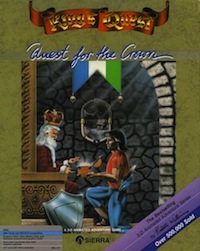 King’s Quest: Quest for the Crown, Sierra’s ground-breaking title, turns thirty this July. Easily the most ambitious (and expensive) adventure game developed as of its release in 1983, King’s Quest set the stage for a whole new kind of interactive entertainment. The game was hugely successful, came to spawn eight sequels, half a dozen spin-off “Quest” franchises, and a hugely loyal fan base. The game also launched Sierra Online into the heart of the games industry, and set the gold standard for the nascent genre.
King’s Quest: Quest for the Crown, Sierra’s ground-breaking title, turns thirty this July. Easily the most ambitious (and expensive) adventure game developed as of its release in 1983, King’s Quest set the stage for a whole new kind of interactive entertainment. The game was hugely successful, came to spawn eight sequels, half a dozen spin-off “Quest” franchises, and a hugely loyal fan base. The game also launched Sierra Online into the heart of the games industry, and set the gold standard for the nascent genre.
Adventure gaming evolved over the years. The genre peaked in the late 1990s with titles such as Gabriel Knight and Phantasmagoria —but as console gaming took over the industry, adventure games went into hibernation. Only with the advent of mobile and tablet gaming did the genre rise from the ashes; the App and Android stores are now full of classic adventure games, including ports, HD updates, and plenty of new titles. The trend has been helped along by crowd-funding: as of this writing, Kickstarter campaigns have successfully rebooted both the Space Quest and Leisure Suit Larry series, with talk of a Police Quest Kickstarter down the road. (And those are just the Sierra games. Plenty of other adventure franchises are seeing their own second coming.)
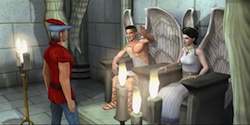 Yet despite all the ups and downs, the King’s Quest games have remained almost mythical in the annals of adventure gaming. No other series has achieved quite the same level of success: to date, the franchise includes four ultra-classic games (KQ 1-4), three point-and-click games (KQ 5-7), three visually enhanced re-releases for Mac/PC (KQ1-3), a controversial 3D game (KQ8), a five-chapter CG fan game (KQ: The Silver Lining), three separate attempts at a ninth installment, and now an upcoming reboot from Activision. The Kingdom of Daventry may have aged, but the series has most certainly endured.
Yet despite all the ups and downs, the King’s Quest games have remained almost mythical in the annals of adventure gaming. No other series has achieved quite the same level of success: to date, the franchise includes four ultra-classic games (KQ 1-4), three point-and-click games (KQ 5-7), three visually enhanced re-releases for Mac/PC (KQ1-3), a controversial 3D game (KQ8), a five-chapter CG fan game (KQ: The Silver Lining), three separate attempts at a ninth installment, and now an upcoming reboot from Activision. The Kingdom of Daventry may have aged, but the series has most certainly endured.
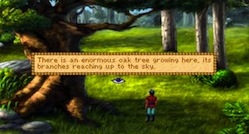 What makes this series evergreen? Truth told, the games are simple—interactive stories set in imaginative worlds like living puzzle boxes. You need to enter a castle, but there’s a dog blocking the door. So you find a stick in the forest, throw it on the roof, and voila—open sesame. That’s the genre in a nutshell, but what set this series apart were two things. First, the world of the games was amazing. They were a mash-up of fairy tales, high fantasy, ancient myth, and tongue-in-cheek humor, somehow managing to be both earnest and light-hearted, both familiar and extraordinary. This was the particular genius of Ken and Roberta Williams.
What makes this series evergreen? Truth told, the games are simple—interactive stories set in imaginative worlds like living puzzle boxes. You need to enter a castle, but there’s a dog blocking the door. So you find a stick in the forest, throw it on the roof, and voila—open sesame. That’s the genre in a nutshell, but what set this series apart were two things. First, the world of the games was amazing. They were a mash-up of fairy tales, high fantasy, ancient myth, and tongue-in-cheek humor, somehow managing to be both earnest and light-hearted, both familiar and extraordinary. This was the particular genius of Ken and Roberta Williams.
 The second thing were the characters. The royal family of Daventry were perhaps the most likable protagonists in gaming history. Conventional wisdom says that good stories are rooted in conflict between the main characters. Not so with these royals. Graham, Valanice, Alexander, and Rosella were humble, thoughtful, respectful, and dedicated—and therein lay their appeal. There’s something to be said for a story in which the heroes are not soldiers, thieves, assassins, and tyrants (no offence to the Lannisters), but moms, dads, brothers and sisters, venturing into peril armed only with their hearts and minds. You rooted for these guys because you were these guys. And just like you, all they really wanted was to keep the realm at peace, and be together with each other.
The second thing were the characters. The royal family of Daventry were perhaps the most likable protagonists in gaming history. Conventional wisdom says that good stories are rooted in conflict between the main characters. Not so with these royals. Graham, Valanice, Alexander, and Rosella were humble, thoughtful, respectful, and dedicated—and therein lay their appeal. There’s something to be said for a story in which the heroes are not soldiers, thieves, assassins, and tyrants (no offence to the Lannisters), but moms, dads, brothers and sisters, venturing into peril armed only with their hearts and minds. You rooted for these guys because you were these guys. And just like you, all they really wanted was to keep the realm at peace, and be together with each other.
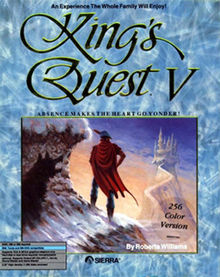 In honor of the thirtieth anniversary, I’m replaying the two best entries in the series: King’s Quest 5: Absence Makes the Heart go Yonder, and King’s Quest 6: Heir Today, Gone Tomorrow. As a kid, KQ5 was my favorite. It was the first time I’d ever seen VGA graphics, and prompted me to ask my parents to upgrade my Apple IIc to a 386 PC. The story of the game was simple: Graham’s family gets whisked away by an evil wizard, and Graham sets off to find them. He wanders a landscape twenty-four screens square (not counting the infinite desert), talking with witches, beguiling woodworkers, finding needles in haystacks, and trying to traverse a mountain pass into the lands beyond. I’ll never forget the moment I finally made it out of that valley. What would I find in those snowy peaks? The answer was simple: adventure.
In honor of the thirtieth anniversary, I’m replaying the two best entries in the series: King’s Quest 5: Absence Makes the Heart go Yonder, and King’s Quest 6: Heir Today, Gone Tomorrow. As a kid, KQ5 was my favorite. It was the first time I’d ever seen VGA graphics, and prompted me to ask my parents to upgrade my Apple IIc to a 386 PC. The story of the game was simple: Graham’s family gets whisked away by an evil wizard, and Graham sets off to find them. He wanders a landscape twenty-four screens square (not counting the infinite desert), talking with witches, beguiling woodworkers, finding needles in haystacks, and trying to traverse a mountain pass into the lands beyond. I’ll never forget the moment I finally made it out of that valley. What would I find in those snowy peaks? The answer was simple: adventure.
 King’s Quest 6 was the most creative entry in the saga. In that game, you find a magic map that lets you teleport between the isles of an archipelago. Each island is a magical place, filled with elements of fantasy, but impenetrable until you find items on the other islands that allow you to explore deeper. For days, I tried to scale the Cliffs of Logic on the Isle of the Sacred Mountain. I was stumped—until one day I found a secret code in the user’s manual that caused hand-holds to emerge from the rocks! Finally, I ascended that cliff, and once again my imagination was set alight.
King’s Quest 6 was the most creative entry in the saga. In that game, you find a magic map that lets you teleport between the isles of an archipelago. Each island is a magical place, filled with elements of fantasy, but impenetrable until you find items on the other islands that allow you to explore deeper. For days, I tried to scale the Cliffs of Logic on the Isle of the Sacred Mountain. I was stumped—until one day I found a secret code in the user’s manual that caused hand-holds to emerge from the rocks! Finally, I ascended that cliff, and once again my imagination was set alight.
In the years since, I’ve played many kinds of games, including complex and sophisticated RPGs. But thinking about those King’s Quest games, I believe they were perfect for their time. Fighting monsters wouldn’t have made them more captivating. Powerful weapons wouldn’t have added to the excitement. The games appealed to my sense of adventure, pure and simple, and that in itself was rewarding. This is a lesson I think the game industry forgot for many years, but which is thankfully being rediscovered once more.
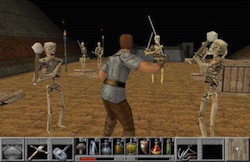 Not every King’s Quest game was a hit. King’s Quest VII: The Princeless Bride, a cell-shaded adventure starring Valanice (Graham’s wife), came across as too cartoony for audiences who had grown used to a more realistic style. King’s Quest VIII: Mask of Eternity, the first 3D installment in the series (and the only one to include battle elements) was criticized for meddling with the time-trusted formula. (Though the game sold twice as many copies as Grim Fandango that same year.) But despite those mishaps, the King’s Quest brand remains legendary—so much so that three different studios have tried to make a ninth installment in the last decade. The latest aborted effort was by Telltale Games, makers of The Walking Dead (the 2012 Game of the Year); the rights have now reverted to Activision, who claim to be developing their own next-generation King’s Quest game.
Not every King’s Quest game was a hit. King’s Quest VII: The Princeless Bride, a cell-shaded adventure starring Valanice (Graham’s wife), came across as too cartoony for audiences who had grown used to a more realistic style. King’s Quest VIII: Mask of Eternity, the first 3D installment in the series (and the only one to include battle elements) was criticized for meddling with the time-trusted formula. (Though the game sold twice as many copies as Grim Fandango that same year.) But despite those mishaps, the King’s Quest brand remains legendary—so much so that three different studios have tried to make a ninth installment in the last decade. The latest aborted effort was by Telltale Games, makers of The Walking Dead (the 2012 Game of the Year); the rights have now reverted to Activision, who claim to be developing their own next-generation King’s Quest game.
Given the resurgence of the genre, King’s Quest 9 may finally be on the horizon. We’ll have to see. But whatever happens, the series remains an icon of gaming’s humble roots. King’s Quest gave us dragons and ogres, yetis and mermaids, unicorns and minotaurs—and it gave us a whole new kind of adventure. These were games about family and imagination, about wit being mightier than the sword. There were about a place where anyone—even a seven-year-old sitting at a pre-historic computer—could set out on a quest, and find himself king.
Brad Kane works in the entertainment industry and is a story consultant on Universal’s upcoming adaptation of The Wheel of Time. Brad has worked at Pixar Animation Studios, DreamWorks Animation, and as a member of the video game press, where he focuses on the intersection of storytelling and interactivity. Get in touch with him if you have any questions, comments, or general thoughts on the nature of human existence.










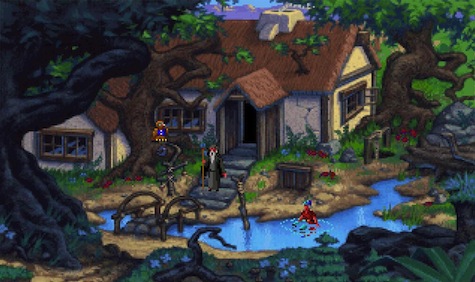
We had an Apple II when I was, I dunno, 3 or 4, and we had King’s Quest. I learned how to read and type so that I could play that game. It definitely seems novel these days to have a game where the protagonist is a knight who does practically no fighting, other than fulfilling fairy tail tropes–witches must be pushed into their own ovens, vampires must be staked. Trolls must be knocked into rivers by billy-goats. Killing a hungry lion is frowned upon, however.
Hmm. I hadn’t thought of giving these games to my 8 year old son. I think it’s time to find the latest re-make of KQ1 and have him give it a try.
NO MENTION OF THE BOOK TRILOGY?!!! FOR SHAME!!! Seriously, took me forever but all three of those novels were good. Especially Kingdom of Sorrow with Graham, but Floating Castle was also awesome.
This series DEFINES my childhood. I still have all 8 games. My brother got me the first 7 in their rerelease pac. I don’t even have new games on my laptop. Just King’s Quest. If I want to play a game to kill some time, I put on King’s Quest 6, my favorite. I’ve beaten that game so many times now I don’t even have to look up anything. And it’s STILL so much fun to play.
My brothers and I were also really into the Quest for Glory games, my older brother liked Space Quest, but for me King’s Quest was were it was at. These are still my favorite games of all time, and I can’t WAIT for King’s Quest 9 if we have one.
I LOVED King’s Quest 8 too. Even though I wasn’t playing as a member of the royal family, that didn’t bug me. I thought the game was REALLY expansive. The worlds in it were amazing. I loved that we went back to Daventry and back to the Underworld. I thought the graphics at the time were amazing. I loved how much stuff there was to do in that game. Plus it finally included fighting which was something I’d always wanted the series to include. So for me, King’s Quest 8 is probably my third favorite behind 6 and 5.
I’m not especially enthusiastic about tablets, but this seems like a genre that’s tailor-made for them. Though I hope they would make it easier to hunt pixels for those of us with giant hands.
King’s Quest IV will aways hold a special place in my heart (and King’s Quest V, to a lesser extent). And I LOVED the giant guide that covered all five games.
King’s Quest IV will aways hold a special place in my heart (and King’s Quest V, to a lesser extent). And I LOVED the giant guide that covered all five games.
One of the defining moments of my childhood was when we upgraded our IBM PC Jr. from 128 to 256 KB of RAM so that we could run the new King’s Quest (II or III, I think?). It’s kind of mind-boggling to think how much computers have changed since then.
Remember that power ballad included on the CD-ROM version of KQ6, along with the little flyer asking you to call in to your local radio station and request it? That sure took the world by storm! Still, in 1993 it was fairly impressive.
http://www.youtube.com/watch?v=69M2iiI__XQ
I was pretty big into Space Quest, but loved King’s Quest when I finally played V. My friend’s and I still quote the owl (“Graaahaaammm”) and the water-drinking – “Water – necter of the gods!”
“It’s a poooooisonous snake!”
I wonder how many of there are out there are out there that learned to type just by playing these and the other classic Quests? I went from hunt-and-peck to what I now call advanced-hunt-and-peck. Not perfect, and the fingers not in the right places, but I can touch type and do it at a speed faster than most. All from gaming. And some people call it a waste… Hmph. :)
The original King’s Quest was released as a showcase game for the IBM PCjr. Only one problem… the IBM PCjr was released in January 1984. Could you please explain how King’s Quest is celebrating its 30th anniversary if the system it was originally built for wasn’t released yet?
What’s cell-shaded? I believe you mean cel shaded.
“have now reverted to Activision, who claim to be developing their own next-generation King’s Quest game.”
Activision themselves have claimed no such thing.
@12 — Thanks for the correction. The official release date for King’s Quest 1 is mid-1984; however the game was developed, completed, and made available outside of Sierra in late 1983. So perhaps we can still count ourselves within th 30th anniversary window.
@13 — It’s only hearsay, but the guys at Activision told Paul Trowe (of Replay Games) that they are indeed planning to do the next KQ game themselves. We’ll have to see whether that turns out to be true.
King’s Quest VI came out while I was in college and it remains one of my favorite games ever. I tried VII when it came out, but I wasn’t able to get into it.
Does anyone know how I could play KQVI these days? I have a Mac.
@15
Best way would be to buy the Kings Quest 4, 5 & 6 pack from Good Old Games
http://www.gog.com/gamecard/kings_quest_4_5_6
The GoG installer basically wraps the games in a customised Dosbox engine, so takes all the tweaking out of the equation, the game will run fine on any windows PC.
Not sure how well the mac will cope, but you can probably install the Mac version of Dosbox and open the game from there.
@16 – Thanks!
Not to be pedantic, but King’s Quest VII was not cel-shaded. Cel-shaded applies specifically to 3D computer models that are rendered in such a way as to mimic hand drawings. The Princeless Bride was literally hand-drawn, frame by frame, exactly like the Disney films of the 1940s and 50s and such.
Lol, good catch Rudy. This doesn’t appear to be the anniversary at all. Oh well!
I have to say though, that complaints about KQVII seem pretty silly two decades later. The King’s Quest games were always pretty silly and cartoony, and the game was pretty beautiful. I replayed it a couple of years ago and found it quite difficult too!
King’s Quest V was one of the highlights of my ’90s multimeda experience. I pushed the Laser 386SX to its limis playing it, Return to Zork and the original SimCity.
Nice write up!